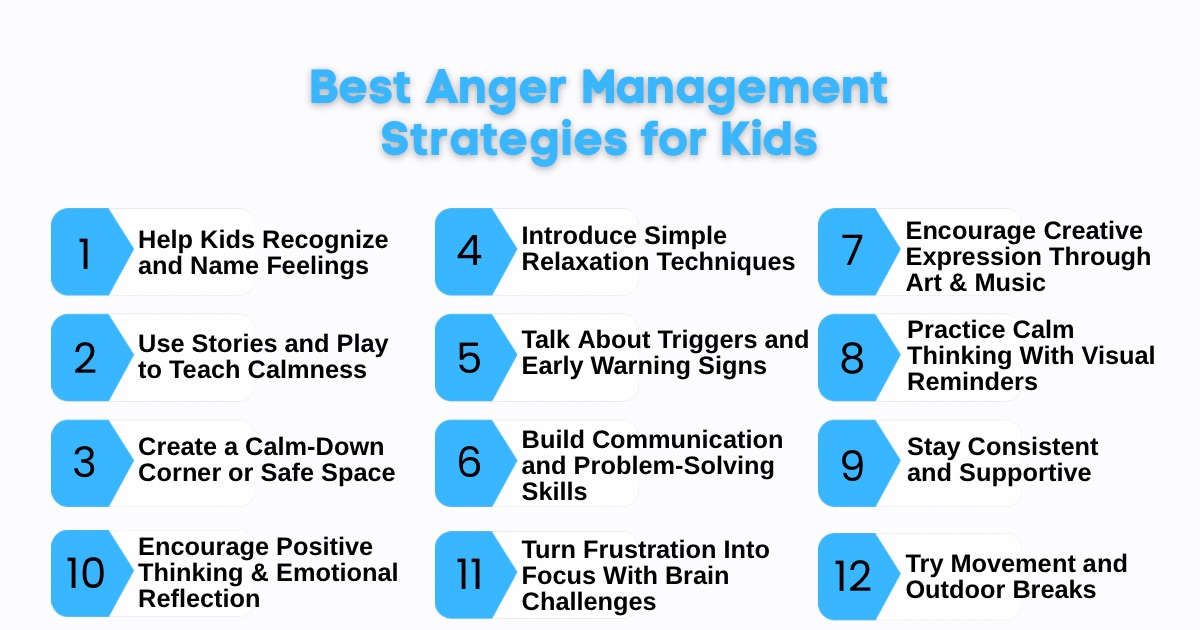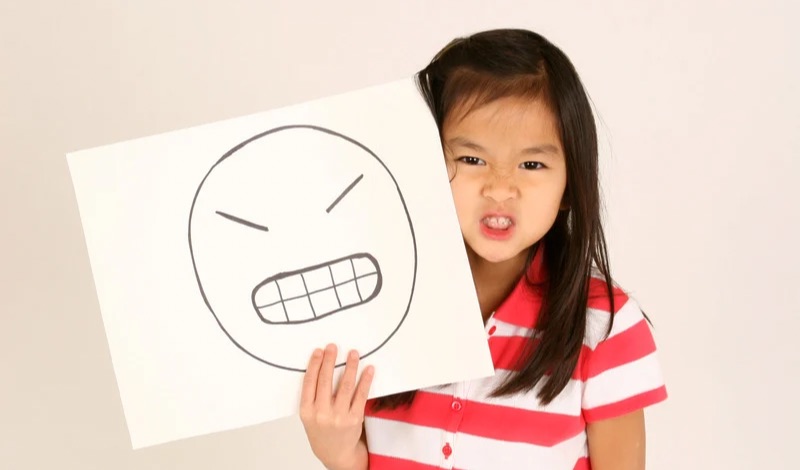What Are the Best Anger Management Techniques for Kids?
Key Highlights
- Anger is a natural emotion in children that often signals unmet needs or frustration.
- Understanding common triggers helps parents respond with empathy instead of punishment.
- Early signs like tense posture, loud voice, or tears show when anger is building up.
- Gentle anger management techniques for kids, such as deep breathing, movement, and calm spaces, build self-control.
- Storytelling, art, and role-play help kids express emotions in healthy, creative ways.
- Consistent routines, calm communication, and patient guidance reduce anger outbursts over time.
- Parents who model calm reactions teach emotional awareness and trust through example.
- With practice and positive support, every angry moment can become a chance for growth and connection.
Every parent has been there. Your child’s face turns red, their voice rises, and before you know it, you’re in the middle of a full-blown meltdown over something as small as the wrong color cup. In that moment, it can feel impossible to know what to say or do. You’re trying to stay calm, but their frustration seems to grow no matter how gently you respond.
The truth is, anger in children isn’t just about bad behavior. It’s often your child’s way of saying, “I’m overwhelmed and I don’t know how to tell you.” When they don’t yet have the words or skills to express what’s going on inside, those big feelings can spill out as tears, shouting, or even a burst of anger.
What looks like defiance is usually a cry for understanding and connection. However, for many parents, these moments bring guilt, confusion, and exhaustion, especially when nothing seems to work for long.
The good news is that anger can be managed with patience, structure, and understanding. This blog will walk you through gentle, practical anger management strategies for kids that help them express strong feelings in healthy ways. Together, we’ll explore what anger really means, how to spot early signs, and how simple daily habits can guide your child toward calm, confidence, and emotional balance.
Understanding What Anger Really Means for Kids
Anger can feel big and messy, but it’s also a normal and healthy part of growing up. For children, learning to feel and express anger is just as important as learning kindness or patience. When parents treat anger as something to explore rather than control, kids begin to see it as an emotion they can understand and learn from. Every angry moment becomes a chance to build self-awareness, practice calm, and strengthen the bond between parent and child.
Anger Is a Signal, Not a Problem
When kids lose their cool, it can seem like they’re being difficult, but more often it’s their way of saying they’re struggling. They might not have the words to explain what’s wrong, so their frustration comes out through tears, shouting, or silence. What helps most in those moments isn’t a quick fix but calm reassurance, showing them that it’s okay to feel big emotions and that they’re safe while they work through them. Even a small gesture of patience can make anger feel less scary and more manageable for both parent and child.
What Are the Common Triggers Behind the Outbursts?
Children often feel angry when something seems unfair or when their needs aren’t being met. Some triggers are simple, while others run a little deeper.
Physical triggers include:
- Hunger or thirst
- Feeling tired or lacking sleep
- Overstimulation from noise, lights, or crowds
- Needing downtime after a busy or exciting day
Emotional triggers include:
- Feeling ignored or left out
- Struggling with disappointment or losing a game
- Feeling embarrassed or misunderstood
- Wanting independence but not getting it yet
What Does Anger Look Like in Kids?
Anger shows up differently for every child, and that’s perfectly normal. Paying attention to their unique signs isn’t about stopping the feeling but understanding it as it unfolds. When parents notice these cues with patience and curiosity, they can help children stay connected to their emotions and learn that it’s okay to feel angry without losing control.
Physical signs include:
- Clenched fists or jaw
- Tense body or rigid posture
- Red face or flushed cheeks
- Loud or shaky voice
- Quick breathing or pacing around
Emotional signs include:
- Crying or sudden tears
- Pulling away or refusing to talk
- Arguing, blaming, or using defensive language like “You never listen to me!”
- Struggling to focus or calm down even after a small problem
Noticing these signals early isn’t just about stopping anger. It’s a chance to pause, sit beside your child, and help them name what they’re feeling. Reflecting their emotions shows that it’s safe to feel upset or frustrated. Over time, this gentle understanding helps them calm down and trust that strong emotions can be managed safely.
What Are the Best Anger Management Strategies for Kids?

Learning to manage anger is an important life skill for young children. Anger itself isn’t wrong; it’s a normal reaction to frustration or disappointment. What truly matters is helping kids find better ways to handle those strong feelings before they turn into anger outbursts.
Let’s look at a few gentle, practical ways you can guide your child toward calm and confidence.
1. Help Kids Recognize and Name Feelings
One of the first steps in anger management is helping kids understand what emotions feel like. Talk about different feelings on a regular basis so your child learns that it’s okay to be sad, mad, or disappointed. You might say, “It looks like you’re having some strong emotions right now. Can you tell me what’s going on?”
Teaching emotional words gives them the vocabulary to express their needs instead of acting out. Over time, this builds stronger social skills and better emotion regulation.
2. Use Stories and Play to Teach Calmness
Kids often understand big ideas through play. Read storybooks that explore big emotions and how characters handle feelings of anger in healthy ways. During playtime, you can also act out short situations and show how to respond in a constructive way.
This kind of gentle learning not only encourages positive behavior but also helps your child see you as a good example of calmness and control.
3. Create a Calm-Down Corner or Safe Space
When anger rises, having a safe space makes all the difference. You can create a cozy spot with soft pillows, coloring books, or a stress ball for sensory comfort. Encourage your child to visit this area when they notice early signs of anger, like tight fists or a raised voice.
It’s not a place for punishment but for comfort and reflection. Practicing this regularly teaches self-awareness and helps your child build lifelong coping skills.
4. Introduce Simple Relaxation Techniques
Simple calming activities can work wonders. Practice deep breathing together, counting slow deep breaths until the body starts to relax. You might even turn it into a fun game with bubbles or feathers. Pair this with gentle physical activity, such as stretching or dancing, to release built-up tension.
Sometimes, offering a drink of water can also help shift focus and calm the body. These fast anger management techniques for kids can make emotional regulation easier, especially for younger children during the preschool years.
5. Talk About Triggers and Early Warning Signs
Every child’s anger has a reason behind it. Take time to understand the underlying issues or environmental factors that might contribute to frustration, such as hunger, overstimulation, or hyperactivity disorder.
Talk through these moments calmly and help your child recognize what happens before outbursts of anger occur. With gentle consistency, you can guide them toward identifying the early signs of anger and choosing calmer responses.
6. Build Communication and Problem-Solving Skills
Help kids find their voice during tense moments. Teach “I feel” statements to express needs respectfully, like “I feel upset when my toy breaks.”
Encourage listening, taking turns, and brainstorming coping strategies together. This kind of teamwork boosts social skills and gives kids anger management skills that they’ll carry into every part of life.
7. Encourage Positive Thinking and Emotional Reflection
After a challenging moment, take time to talk about what worked and what didn’t. Replace negative thoughts with hopeful ones like, “I can try again tomorrow.” Offer lots of praise for calm behavior and consistent consequences when needed.
This helps your child understand that good behavior and responsibility go hand in hand. Over time, these small, loving efforts lead to stronger emotional regulation and fewer angry feelings.
8. Encourage Creative Expression Through Art and Music
Art and music give kids a safe, expressive outlet for strong emotions they can’t always describe in words. Drawing, painting, or listening to calming tunes helps release tension and turns big feelings into creativity.
You can keep simple art supplies or a few favorite songs ready for moments when emotions start to rise. Over time, these creative breaks teach kids that expressing themselves in healthy ways feels good and helps them think more clearly.
9. Practice Calm Thinking With Visual Reminders
Children often benefit from visual cues that remind them how to stay calm. Create a small “calm card” or poster with pictures that show steps like taking deep breaths, counting slowly, or asking for help.
Keep it in their playroom or backpack as a gentle reminder during tough moments. These visual tools make anger management easier to remember, especially for younger children who learn best through seeing and doing.
10. Stay Consistent and Supportive
Building coping skills takes hard work, and your encouragement makes all the difference. Keep a regular routine, stay calm in your own reactions, and remember that change happens gradually.
If your child struggles despite your efforts, seeking professional help or anger management counseling for kids can be a supportive next step. Working with anger management counselors for kids can make the process smoother for everyone.
11. Give Challenges Like Puzzles and Brain Teasers
Sometimes kids need a positive way to redirect their energy when they feel upset. Offering small challenges like puzzles, brain teasers, or simple problem-solving games can help shift their focus and engage their thinking mind instead of their anger.
These quiet activities encourage patience, concentration, and confidence, all of which make it easier for children to calm down and feel in control again.
12. Try Movement and Outdoor Breaks
Physical activity helps release built-up frustration in a healthy way. Encourage kids to jump, run, ride a bike, or simply walk outside for fresh air when they feel angry. Movement helps reset both body and mind, making it easier to return to calm thinking.
Teaching kids to manage anger takes patience and practice, but every small step helps them grow stronger emotionally. Keep using these gentle strategies daily and watch your child learn to handle big emotions with calm and confidence.
Every Step Toward Calm Makes a Big Difference
Helping kids manage anger isn’t about stopping their feelings; it’s about teaching them how to understand and express them in healthy ways. Every time you respond with calm and compassion, you show your child that emotions are nothing to fear. These small, everyday moments of guidance slowly build self-control, empathy, and confidence: qualities that will serve them for life.
The process takes time, and some days will feel harder than others, but every effort you make truly counts. Keep using these simple anger management techniques for kids, offer comfort when emotions run high, and celebrate progress along the way. With patience and consistency, you’ll help your child turn strong emotions into opportunities for growth, connection, and calm.
Frequently Asked Questions
How do I teach my sons to manage anger?
Start by helping them name their feelings and recognize when anger begins. Encourage deep breathing, breaks, or physical activity to release tension. Try simple anger management activities for kids that make learning calm behaviors fun. Praise small efforts toward self-control and empathy.
How to discipline a child without falling prey to anger?
Stay calm and focus on guiding, not punishing. Use clear boundaries and consistent consequences. Take a pause before responding when you feel frustrated. Gentle discipline works best when paired with empathy, understanding, and opportunities for learning and reflection.
How to reduce anger in kids?
Create predictable routines, encourage open conversations about feelings, and provide outlets like drawing or outdoor play. Teach relaxation techniques such as deep breathing and counting slowly. When children feel safe, heard, and supported, their anger naturally becomes easier to manage.
What are coping skills for anger for kids?
Coping skills include taking deep breaths, squeezing a stress ball, walking away to calm down, or talking to a trusted adult. Building strong anger management skills for kids also helps them handle frustration confidently in school, at home, and in social situations.
Are there any anger management techniques for kids with autism?
Yes. Focus on structured routines, visual aids, and calm-down spaces. Use sensory-friendly tools like weighted blankets or fidget items. Teach simple relaxation techniques with visuals or short videos to support understanding. Consistent, patient guidance helps children feel more secure.
What are the best anger management therapy techniques for kids?
Effective therapy techniques often include role-play, mindfulness activities, emotion cards, and positive reinforcement. Therapists may also teach problem-solving and relaxation exercises. Families can search for anger management for kids near me to find local professionals who support children in developing calm and confidence.
Share This Story, Choose Your Platform!
Total Life Counseling Center consists of Licensed Counselors, masters level therapists, Español counselors, Licensed Mental Health Counselors, business coaches, and image enhancement coaches who provide counseling for emotional, mental, physical and spiritual care including marriage, individual, family, substance abuse and more. TLC’s family, trauma and marriage experts have been interviewed on National and Local TV/Radio over 200 times for their expert advice on Fox News, OWN, WETV, ABC’s Medical Minute and more. Our skilled counselors are relational, approachable and specialists providing therapy services in the Central Florida area including: Orlando, Winter Park, MetroWest, Windermere, Dr. Phillips, East Orlando, Lake Mary, and Clermont, Boca Raton Florida, and Dallas, TX.






